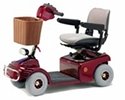Where Can I Find Elderly Incontinence Bed Pads?
I'm learning a lot from all of you. Congratulations!
Where I can find non disposable (washable) bed pads?
Reply:
Great question. Incontinence bed pads come in handy both on a bed as well as a chair or couch.
It's always a good idea to have a number of bed pads on hand. Depending on how often they need to be changed - it may be a good idea to have at least 3 so you do not have to wash them every day.
In addition, encouraging your loved one to use incontinence pads or underwear at night and/or during the day can also help.
There are 3 Main Sources:
1) Buy Local - from a local medical supply store. They come in a variety of sizes and weights (thicknesses).
Sizes range from 81" x 35" for beds to 24" x 17" for chairs.
2) Buy Online - from an online medical supply store or Amazon.com
Amazon seems to have the best prices and I've always been happy with the service of their sellers. You can also see how others have rated their service.
Search "washable incontinence bed pads".
3) Make Your Own - If you have the time and inclination - sewing your own washable incontinence bed pads could save you some money.
I've met some families who have sewn nylon fabric onto a terry cloth towel. The nylon protects the bed, chair, etc and the terry cloth towel absorbs the wetness.
You can also make a quilted bed pad similar to store bought bed pads.
The Benefits of Washable Incontinence Bed Pads:
- Do not have to change sheets as regularly if the person is incontinent
- Changing a bed pad is more discreet than changing sheets after each accident which can be embarrassing
- Easier to change a bed pad than bottom sheet - especially at night
- Along the same line - the senior/elderly could discreetly put the bed pad in the laundry in the morning instead of having to ask for assistance in changing the sheets
- Protects mattress as well as chairs, couches, car seats, wheelchairs, etc from getting wet
- Better for the environment than disposable bed pads
Other Tips for Managing Elderly Incontinence:
- Talk to their doctor about their incontinence and possible causes, treatment, etc.
- Talk to your loved one regarding how they feel about it and what they prefer (incontinence products such as pads, underwear, bed pads as well as a bedside commode)
- If your loved one is embarrassed by their incontinence, set up a system that is discreet such as having a laundry bin in the room wear they can put the bed pad in the morning. Also having a bedside commode with a pail that they can remove/change themselves.
- Easy to change clothing may help the senior to avoid
- Wearing clothes that do not need to be ironed reduces the time spent on laundry (since they are likely changing their clothes more often)
- Choose clothing fabric and colors that hide incontinence accidents - dark colors tend to show wetness more easily than lighter colors.
- Bring a change of clothes for your loved one when leaving their home if you know they may have an accident when away.
- Use an incontinence bed pad on other seats such as recliner chairs, couches, car seats, etc.
- Do not rush someone who has incontinence issues - they may need more time on the toilet
- Sometimes running water from the tap can help with urinating when on the toilet
- Consider a portable commode at the bedside so the senior does not have to go to bathroom at night (which can be a safety concern as well as they might not make it there if urgency is an issue)
- If the bathroom is not easily accessible for them during the day, consider a commode near the seating area (a nearby bedroom may afford the desired privacy)
- Set the toilet up so that it is safe (ex grab bars, raised toilet seat, toilet safety frame, etc)
- If it is only happening at night, have them stop drinking fluids before 5 or 6pm - depending on when they go to bed. This gives them time to go to the bathroom before going to bed.
- Remind them to go to the bathroom frequently and if they need assistance getting to/from the bathroom - make sure you schedule in times to help them
- Encourage proper personal hygiene as they can develop urinary tract infections (UTIs) - some seniors with decreased memory have issues with personal hygiene for a variety of reasons
- Have incontinence products available in all bathrooms that they use in the home - such as pads and underwear. Make it easy for them to remember to use.
- Choose the right incontinence products that are easy and safe to use and are appropriate for your loved on - some prefer underwear that they step into, others prefer ones with buttons, snaps, tape.
- Consider using reusable incontinence products to reduce waste - although it does increase water and power usage.
Other Incontinence Products:
- Underwear: There are a variety of styles: some that are similar to regular underwear and other have snaps, buttons and/or tape to make it easier to change
- Pads/Liners: These go in regular underwear
- Reusable vs Disposable: Both for underwear and pads/liners
- Absorbency: From light to heavy depending on the seniors need
- Designed for Men or Women: They are designed specifically for the different needs of men and women
Comments for Where Can I Find Elderly Incontinence Bed Pads?
|
Return to Caring for Aging Parents





